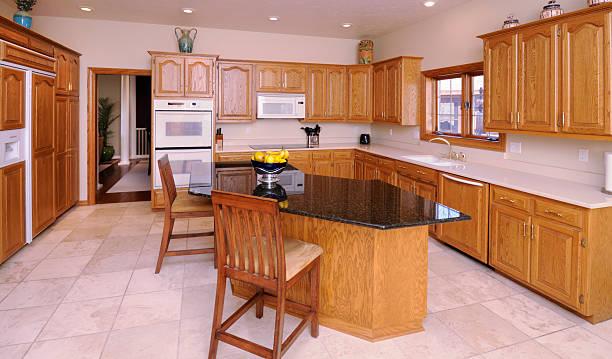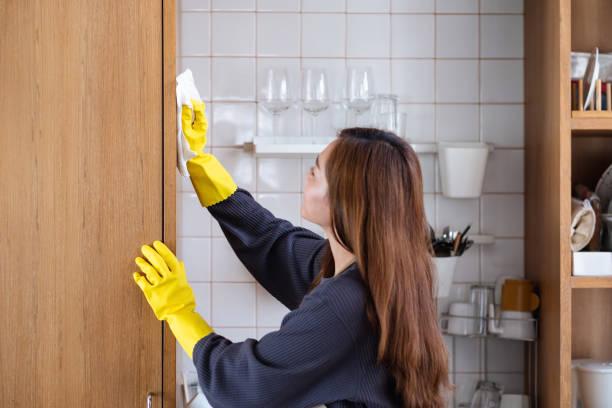When it comes to the heart of your home, nothing beats the warmth and charm of wood kitchen cabinets. However, maintaining their pristine condition requires more than a casual wipe-down. Understanding how to clean wood kitchen cabinets is crucial not only for preserving their aesthetic appeal but also for ensuring their long-term functionality. A well-maintained kitchen exudes a sense of elegance and order, making every cooking experience delightful.

Preparing to Clean Your Kitchen Cabinets
Before engaging deeply in the cleaning process, proper preparation is key. You’ll need the right materials and tools to get the job done efficiently and safely. Here’s a list to get you started:
Microfiber cloths: These are essential for their non-abrasive nature, ensuring your wood doesn’t get scratched.
Gentle cleaning solutions: Avoid harsh chemicals. Opt for mild dish soap mixed with water or specialized wood cleaners.
Soft-bristle brush: Useful for cleaning intricate details and hardware.
Bucket of warm water: For rinsing your cloths and brushes.
Dry towels: To wipe down and dry the cabinets after cleaning.
Preparation involves a few essential steps. First, clear out the cabinets. This makes it easier to reach every nook and cranny. Next, clean around the hardware. If possible, remove the hardware to ensure a thorough clean. This not only facilitates better access but also prevents potential damage to the fixtures.

Step-by-Step Cleaning Guide
Cleaning your wood kitchen cabinets can be broken down into daily routines and more intensive deep-cleaning sessions. Let’s explore both routines to keep your cabinets in tip-top shape.
Daily Cleaning Tips
For a kitchen that always looks picture-perfect, incorporate these quick daily cleaning routines:
1. Wipe Down Surfaces: Use a microfiber cloth to gently wipe down the cabinet surfaces. This helps in removing daily dust and minor spills before they become stubborn stains.
2. Spot Cleaning: For any splatters or sticky spots, use a damp cloth with a tiny amount of gentle dish soap. Immediately follow up with a dry cloth to prevent moisture from seeping into the wood.
3. Handle and Knob Maintenance: The areas around handles and knobs tend to accumulate grease from frequent touching. A quick wipe with a damp cloth can keep these areas clean and shiny.
Deep Cleaning Process
While daily maintenance keeps your cabinets looking fresh, deep cleaning ensures their longevity. Here’s a detailed guide to doing it right:
1. Remove All Contents: Begin by emptying the cabinets completely. This will give you unobstructed access to every surface.
2. Prepare Your Cleaning Solution: Mix equal parts of white vinegar and water in a spray bottle. Add a few drops of dish soap if desired. This natural cleaner is effective and safe for wood.
3. Wipe Down Surfaces: Spray the solution onto a microfiber cloth and wipe down the cabinet surfaces, both inside and out. Avoid spraying directly onto the wood to prevent oversaturation.
4. Tackle Stubborn Stains: For tougher stains, create a paste using baking soda and water. Apply this paste to the stained area and gently scrub with an old toothbrush. Wipe clean with a damp cloth.
5. Rinse and Dry: Once all surfaces are cleaned, use a clean, damp cloth to wipe away any residual cleaning solution. Follow up with a dry microfiber cloth to ensure no moisture remains.
6. Clean the Hardware: If you removed the hardware, soak it in a mixture of dish soap and warm water. Scrub gently with a soft brush, rinse, and dry thoroughly before reattaching.

Special Considerations for Wood Cabinets
Wood requires a delicate touch and specific care to avoid damage and preserve its natural beauty. Here are some tips on protecting them:
Avoid Harsh Cleaners: Steer clear of ammonia-based cleaners, bleach, and any product containing silicone, as these can damage the wood’s finish.
Use Soft Cloths: Always opt for microfiber or other soft, non-abrasive materials.
Commercial Wood Cleaners: If natural solutions don’t work, choose a wood cleaner designed for your cabinet type, following the manufacturer’s instructions closely.
Useful Tips for Maintaining Your Kitchen Cabinets
Regular maintenance is the secret to extending the life of your kitchen cabinets. Here are some tips to keep them looking their best:
1. Polish Periodically: Use a wood polish or conditioner periodically to maintain the shine and protect the wood. Products containing natural oils like lemon or orange oil can be particularly beneficial.
2. Check for Damage: Regularly inspect your cabinets for any signs of damage, such as water spots or warping. Early detection can prevent minor issues from becoming major problems.
3. Ventilation Matters: Ensure your kitchen is well-ventilated. Excess moisture from cooking can lead to wood damage over time. Using exhaust fans can help reduce humidity levels.
Conclusion
Knowing how to clean wood kitchen cabinets is essential for maintaining their beauty and functionality. Regular cleaning, combined with the right techniques and products, ensures that your cabinets remain the pride of your kitchen. By following these expert tips and incorporating routine maintenance, you’ll keep your kitchen looking pristine and welcoming for years to come. Remember, a well-cared-for kitchen is a joy to cook in and a delight to behold. So, roll up those sleeves and give your wood cabinets the care they deserve!
FAQs
1.What is the best natural cleaner for wood kitchen cabinets?
A natural cleaner for wood kitchen cabinets is a solution of water and mild dish soap. This gentle mix can effectively remove grime without damaging the wood. For deeper cleaning, add white vinegar to enhance its grease-cutting power.
2.How often should I deep clean my kitchen cabinets?
Deep cleaning of kitchen cabinets should be done every three to six months. Regular cleaning helps maintain their appearance and hygiene by removing accumulated dust, grease, and debris.
3.Can I use commercial cleaners on wood cabinets?
You can use commercial cleaners on wood cabinets, but choose those specifically designed for wood. These are usually milder and help preserve the finish and integrity of the wood. Avoid harsh chemicals that can strip or damage the finish.
4. What should I do if my cabinets get too wet during cleaning?
If your cabinets get too wet during cleaning, immediately dry them thoroughly with a soft, absorbent towel. Avoid letting water sit on the wood to prevent damage and warping. Maintain good ventilation to help the wood dry completely.
